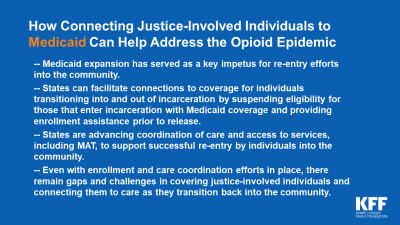 How Connecting Justice-Involved Individuals to Medicaid Can Help Address the Opioid Epidemic
Issue Brief
How Connecting Justice-Involved Individuals to Medicaid Can Help Address the Opioid Epidemic
Issue Brief
This issue brief identifies key lessons learned from how four states (Missouri, Ohio, New Mexico, Rhode Island) are connecting people leaving the criminal justice system to Medicaid coverage and services, with a focus on medication-assisted treatment (MAT) and supports for people with opioid use disorder. It builds on previous briefs that assessed state efforts to connect people involved in the justice system to Medicaid coverage. It is based on interviews conducted in late 2018 and early 2019 with state Medicaid, behavioral health, and corrections officials in the four states and in Bernalillo County, New Mexico, as well as interviews with managed care organizations, providers, and advocates in those states and published information on the states’ experiences.